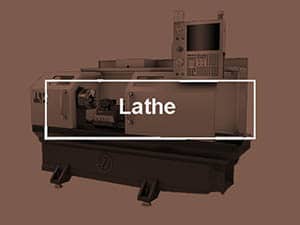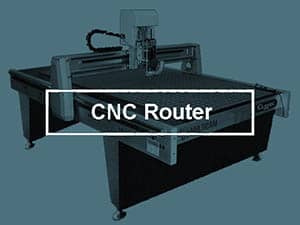CNC Router Bits are uniquely designed to harness the unique features of CNC Routers, in addition to the specific materials and employment scenarios they are utilized in. For a deeper understanding of how a CNC Mill contrasts with a CNC Router, refer to our article.
Key Takeaways
There are several special router bit types that are unique:
- Upcut vs Downcut: Upcut router bits are pretty much the same as any normal endmill. But downcut router bits reverse the forces and force chips down instead of up. This can reduce up-chipping on the cut.
- Compression Cutters: These router bits force chips up from the bottom and down from the top. The idea is to prevent chipping on both the bottom and top of the material.
- Diamond Cut Bits: Diamond Cut Bits are similar to wood rasps.
- Chipbreaker Bits: These are what the metal world calls a "roughing end mill" or "corncob rougher".
- Straight Flute Cutters: These router bits lack any helic in their flutes. They're typically used because they're cheaper than helical flute router bits.
- V-Bit Router Engraving Bit: V-Bits are another bit used for engraving that have very simple geometries.
- Spoilboard Surfacing: These are similar to face mills and fly cutters. They're used to surface large flat areas.
- Drag Knife: These cutters are operated without the spindle spinning. They're literally just knives that are dragged through the material, such as vinyl.
CNC Router Bits Explained
While you can use endmills and twist drills that are typical of the non-router (routers are also called gantry mills, if you prefer) CNC world, there are a number of special CNC Router Bits than can help out in a variety of situations and that's what this article is all about.
For more on regular milling cutters (most of which can also be used on a router except for larger tooling like Face Mills), check out our Total Guide to Milling Cutters. For an even more basic view of how to choose the right cutter, try our series on choosing cutters for mills and routers.
Using these special router bit types can ensure superior smooth quality cuts in wood.
Types of Router Bits
Let's do a quick survey of the types of CNC router bits with some tips for each:
Upcut vs Downcut Router Bit Types
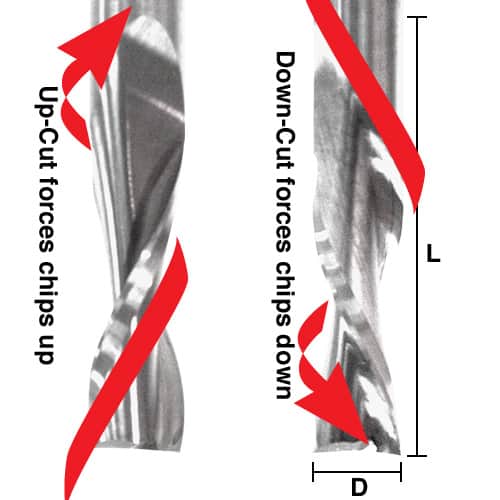
Up-Cut vs Down-Cut Geometry on router bits (Courtesy Eagle America)
Depending on which way the spiral goes on a router bit, you get a cutter that either moves the chips up or down. Whichever way the chips are going, there is also force exerted on the workpiece in the same directions. So, an upcut router bit will move the chips up and out of the cut, and it will tend to pull up on the workpiece. BTW, the conventional endmill world refers to some cutters as left handed or right handed. This is not the same thing because it refers to the actual spindle rotation. You can get left hand (counter-clockwise) rotation router bits, but 95% of downcut router bits are right hand rotation.
Why would you care about a down-cut router bit?
An upcut is a conventional endmill for all intents and purposes. For wood and materials that may chip, it has the disadvantage that it wants to pull chips along the top edge. Since a downcut pushes down, it leaves a cleaner cut on top, but can fray the bottom edge.
Workholding is another issue. The upcut wants to pull up on the workpiece. If you've got a flexible workpiece (think plywood sheet vs a 1/2" aluminum plate-the plywood is flexible), pulling up on it may bow it and make the cut inaccurate. A vacuum table helps a lot with this.
Okay, why not always use the Downcut, get cleaner cuts, and keep the workpiece firmly pressed down onto the table?
The answer is that downcut router bits force the chips down to the bottom of the hole, which is far from ideal. If you read the CNCCookbook blogs, you will have heard me talking about the need to be paranoid about clearing chips. It is less a problem with wood than metal, but it is still very much a problem. Consider using downcut router bits for a final finish pass where there are fewer chips to clear and where you want to avoid chipping the top edge of the cut.
When using our G-Wizard Feeds and Speeds software, treat upcut router bits as normal endmills. For downcuts, select the Endmill type and then choose the "downcut" tip type.
It looks like this:

You will notice that Feeds and Speeds for Downcut Bits are a little slower than for upcut. That's because it's harder to clear chips from a downcut bit.
G-Wizard is actually the first feeds and speeds calculator designed especially with the needs of CNC Router users in mind, and there are many benefits to cnc router users who have a copy.
I had a machinist write with the following anecdote about downcut bits:
On the down cut, the endplug is often not "cut up". It ends up spinning on the end of the bit. I have on more than one occasion had a plug spin inside a cut.... they get so hot that they catch a vac table's low density particle board on fire. Since the vac pump exhausts outside, you often don't realize you got a fire for a while.
Ouch. Router fires can be dangerous, check out our article on them.
One other tip: a lefthand endmill smaller than the diameter of a stuck screw can make a great way to remove the screw. The opposite rotation puts "unscrewing" pressure as material is cut away to loosen the threads.
Compression Router Bit

Compression cutter router bits...
Imagine combining an upcut and a downcut and you've got a Compression Cutter. The flutes literally go one way for the bottom half of the flute length and the other way at the top. Compression cutter router bits are for plywood, composites, and laminates. They're used because the pull towards the middle of the cutter, which reduces chipping on both the top and bottom. Use one to cut completely through a sheet of plywood and you'll have cleaner edges on both sides.
Given the chip clearing problems, and the desired use to prevent chipping, G-Wizard has a special setting for compression cutters. When using our G-Wizard CNC Router Feeds and Speeds Calculator, select an Endmill type and then click the "Compression" Tip Type:
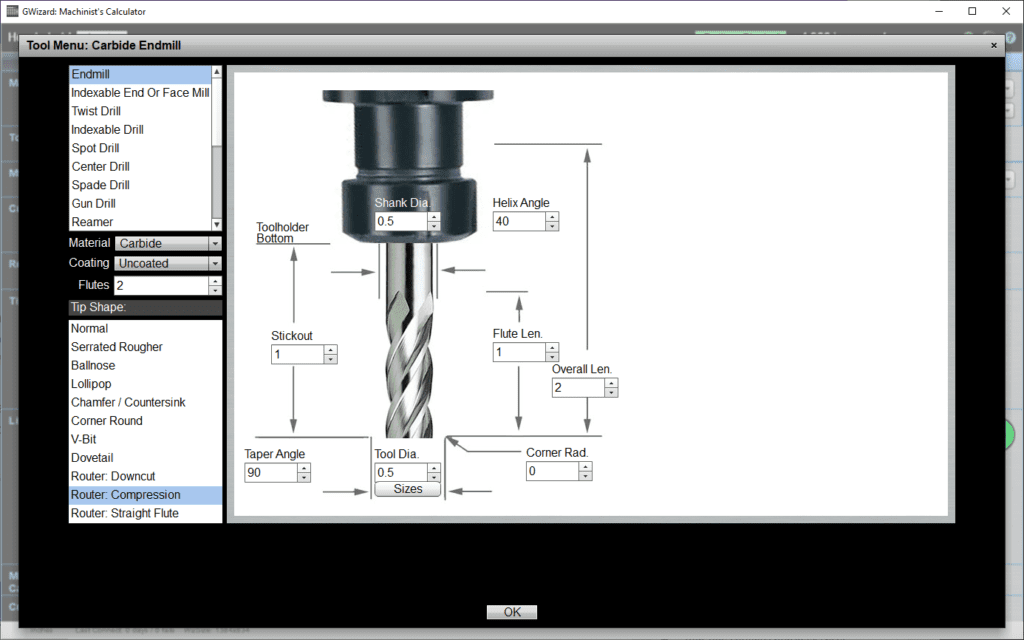
Don't try to use a Compression Cutter on metal!
"Diamond Cut" Bits

Diamond Cut Router Bit...
Now we're talking about some crazy flutes. The Diamond Cut looks a lot like a wood rasp, and that's pretty much what it is. They're great for finishing cuts, but their material removing capacity is limited relative to other kinds of router bits. Since they're gentle on the material, they are often used with composites, PC board material, and other layered materials. Consult the manufacturer's recommendations until we add a "Diamond Cut" choice to G-Wizard, although you're probably fine to run one as an HSS endmill (even the carbide ones) with the Tortoise-Hare set to "Full Tortoise".
Chipbreaker Router Bits
These are what the metal world calls a "rougher" or "corncob rougher". The edges are serrated to break up the chips into smaller pieces and really move some material fast when roughing. I like these bad boys a lot: check out our article on roughers for more info.
In G-Wizard, select an endmill and click the "Serrated Rougher" tip type to pick up the extra performance.
V-Bit Router Engraving Bit
A V-Bit is a special purpose bit intended for engraving. They come in all shapes and sizes, but usually they look something like this:

A V-Bit for Engraving…
They do a very nice job engraving, but feeds and speeds can be a bit tricky for a couple of reasons. First, that sharp point is a bit delicate and the geometry is not nearly as optimized for plowing through tons of material as a helical endmill. The good news is they’re best used with depths of cut of say 0.005 to 0.010″ (0.1 – 0.2 mm). That at least means that chip clearing should be easy and the cutting forces shouldn’t be too great.
That brings me to the second issue, which is that the “diameter” of your cutter is, well, not the diameter in the cut!
Because of that, G-Wizard needs to do compensation to figure the effective geometry just like it does for a ballnosed endmill. In fact, the V-Bit and Ballnosed Endmills are the two most common bits used for CNC Engraving.
Straight Flute Cutters
Saved these for last as I'm not a big fan. A helical flute allows the edge to gradually ramp up its engagement on a chip. For a straight flute, it happens all at once as the entire edge slams into the workpiece. The metal world doesn't see this geometry except in reamers which have an entirely different function. The reason these cutters are made and sold is because they're much cheaper. For CNC, they seem like a waste, and I would definitely never use on on anything but wood or plastics. According to Wealden Tool, a spiral fluted cutter can go 3x faster and leaves a better finish. OTOH, they are cheap. One machinist wrote that he mostly uses straight flute cutters on wood projects because they are so much cheaper.
For feeds and speeds when using our G-Wizard Speeds and Feeds software, select an Endmill type and then click the "Straight Flute" tip type.
Cove Router Bit

Cove Router Bits cut a semi-circular profile. They're typically used to create moulding features in wood applications.
Core Box Router Bit
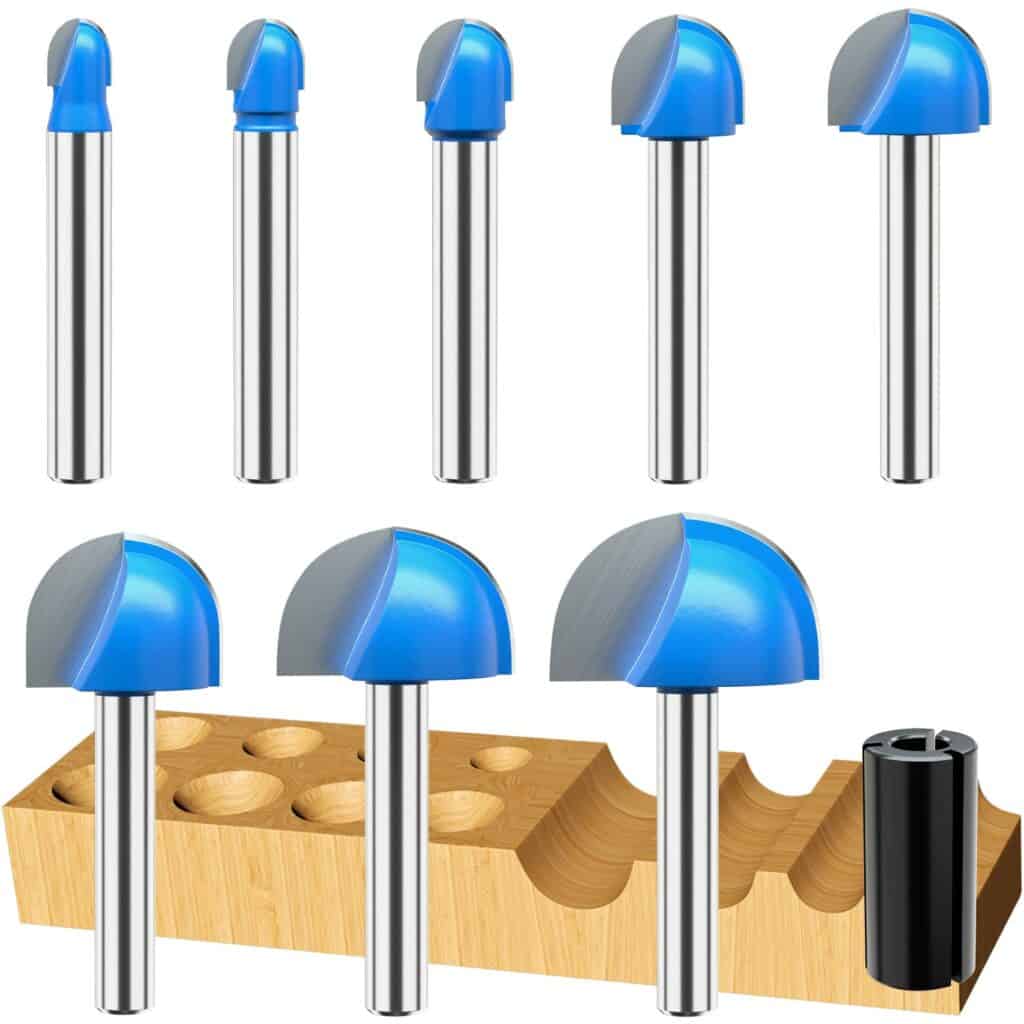
Yet another type of router bit is the Core Box Router Bit.
Spoilboard Surfacing
Spoilboard Cutters are similar to facemills and fly cutters found on conventional CNC milling machines. Their purpose is to make the entire surface of a spoilboard flat as quickly as possible.

A typical spoilboard surfacing router bit, courtesy of Rockler...
To find out how to use these router bits, how to choose the right one for your CNC Router, what the most popular ones are, and how to calculate their feeds and speeds, check out our complete guide to spoilboard cutters.
CNC Drag Knife

While we're calling out CNC Router Cutters, don't forget about the CNC Drag Knife.
CNC Router Bit Feeds and Speeds
If you're cutting wood, refer to our special wood feeds and speeds guide. If you need to calculate feeds and speeds for a CNC Router, be sure to checkout G-Wizard. It has a number of features that make it the most powerful CNC Router Feeds and Speeds Calculator. Plus, you can get a free 30-day trial:

What are the Best CNC Router Bits for Wood?
Any of the router bit types discussed above will work well in wood.
Improve My Feeds and Speeds For
Be the first to know about updates at CNC Cookbook
Join our newsletter to get updates on what's next at CNC Cookbook.

